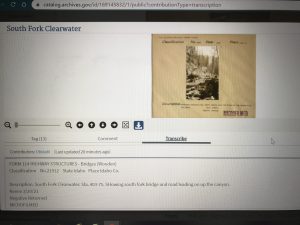Starting July 2020, the Greater Princeton Branch of AYLUS (GPA) has registered with the U.S. National Archives and Records Administration to volunteer online for the Citizen Archivist Program (https://www.archives.gov/citizen-archivist).
Focusing on “Save a Life”, such as healthcare and blood donations history, GPA members are contributing to the National Archives Catalog by tagging, transcribing and adding comments to their records, making them more accessible and searchable. GPA welcomes more students to join this interesting program! Every contribution you make helps unlock history.
Participants: Amber Yu (7/31, 1 hr), James Chen (7/25, 1 hr, 7/26, 1 hr, 7/27, 1 hr, 7/28, 1 hr, 7/29, 1 hr, 7/30, 1 hr, 7/31, 1 hr), Fangyi Chen (8/1, 1 hr), Xiangcheng (Samuel) Ying (7/24, 1 hr, 7/25, 1 hr, 7/26, 1 hr, 7/27, 1 hr, 7/28, 1 hr), and Ruofei (Olivia) Mao (7/31, 2 hrs).
For your information, check into details here:
Register
Citizen Archivists must register for a free user account to contribute to the National Archives Catalog. We encourage you to read our Citizen Contribution Policy. Register now.
How to Contribute
We recommend visiting our Resources page on our dashboard. This page contains step-by-step instructions, and video tutorials and guides to walk you through the process.
Watch our video to learn how to contribute: How to Tag and Transcribe Records
Ready to tag records? Please review our guide: What Makes a Good Tag?
Login
We recommend that you login into your National Archives Catalog account before navigating to our Citizen Archivist Missions, or before selecting a record from the Catalog.
Need help with your Catalog user account? Contact us at catalog@nara.gov
Begin Contributing
- Once you are logged in, perform a search in the Catalog to find records of interest, or choose records from our curated missions.
- Click on the title of an item to navigate to the record’s description, and then select the “View/Add Contributions” button located below all images.
- Select the either the Tag, Comment or Transcribe tab.
- Add your contribution and click “Add” or “Save” to submit your work.
Types of Contributions
Tagging
Tagging is a fun and easy way for you to help make National Archives records more searchable in our catalog. By adding keywords, terms, and labels to a record, you can do your part to help the next person discover that record.
There are two ways to add tags:
- Place tags on the left side column to tag the entire record
- Add tags directly to an individual page under the image using “View/Add Contributions” and select the Tag tab.
Tags can contain these special characters: ! # $ % * / ? ^ { | } ~ ( ) [ ] \ ; : ” . ‘ @ _
Dashes cannot be included in tags.
Separate multiple tags with commas.
The best tags for photographs and graphic materials are when you identify objects or concepts not included in the title or scope and content note of the description. By adding this kind of metadata to records in the catalog, you help make content more discoverable online.
Transcription
All documents are unique and may contain various aspects such as stamps, tables, or charts. Type what you see and follow the order and layout as best you can. Type words exactly as they are written in the document; this includes capitalization, abbreviations, names, dates, and even misspelled words.
Why do we transcribe even typewritten records? The words within those documents are often not picked up by a search in the catalog. When you transcribe, you type exactly what you see in the document, which then makes that content searchable for you or for the next user. When transcribing, don’t worry too much about matching the exact format of the original document, but instead think about how transcribing the text will improve our ability to read the documents, search for them, and use the information they contain.
New to transcription? Please read our Transcription Tips for examples of documents and for help getting started.























